7 Elements of a Great Welcome Email Sequence

This guest post comes for Anna Bradshaw, who writes conversion copy for consumer brands. She loves translating the ideas in her client’s mind into concrete messaging that connects with new customers.
Whether you sell primarily online, or through other retail channels, you should be investing in email marketing. While social media platforms come and go, with algorithms that update every few months, email marketing provides consistent returns.
Getting in your consumer's inbox lets you meet your customer where they’re already hanging out. Not only is it great for sharing promotions, email marketing is an important tool for building brand loyalty.
But you can't leave it to chance - start your email relationship off on the right foot with a killer welcome sequence!
Consumers who just signed up are excited to learn more about you. If you just add them to your regular newsletter list, they might not even remember your name when the next routine email rolls in.
A basic welcome sequence includes 5 - 7 emails sent over the course of a week or two. You want the first one to go out right away - don’t delay this step.
Email copy is an art, and working with a trained copywriter can help you optimize your email marketing program. But even if hiring an email expert isn’t in the cards right now, you can still DIY a welcome sequence that works!
In this post we’ll look at seven elements of a great welcome sequence. Write one email for each of these, and you’ll have a great first-effort in creating the essential email sequence every consumer brand needs - the welcome email.
1) Tell your story
Your welcome sequence is a great chance to share your brand's story. Most website visitors won't take time to click on your About page, so email is a great way to give them a taste of the behind-the-scenes origin of your brand.
As you tell your story, just be careful to keep your messaging customer-focused. They care about doing business with a brand they identify with - they don't care what year you were founded, or whether you got series A funding.
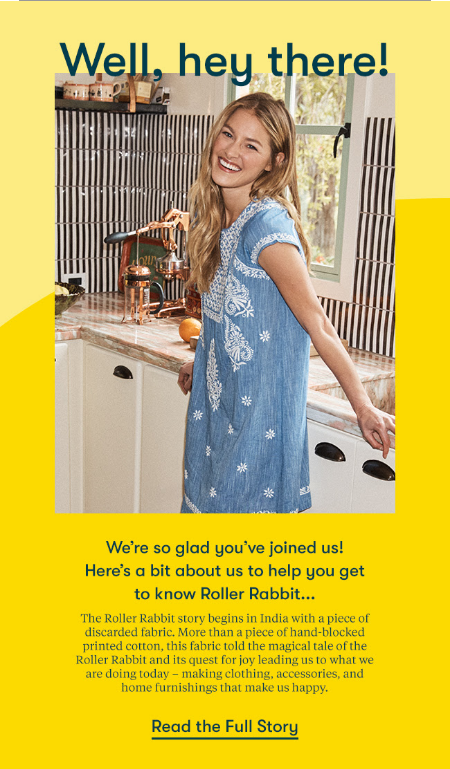
Roller Rabbit introduces their brand story in the first welcome email
2) Introduce the team
Show your faces and build the "like" factor by introducing yourself as the founder, or introducing the rest of the team.
Show your team members’ faces, and give a few fun facts - not just their titles. You don't have to go overboard with creativity - but, a little fun goes a long way.
3) Show off your most popular products
Don't miss the chance to show off your products! Just because everyone on your list opted in through your site, doesn't mean they've spent time learning about your products yet.
Highlight your crowd favorites in your welcome sequence, and mention their popularity - this also helps build authority.
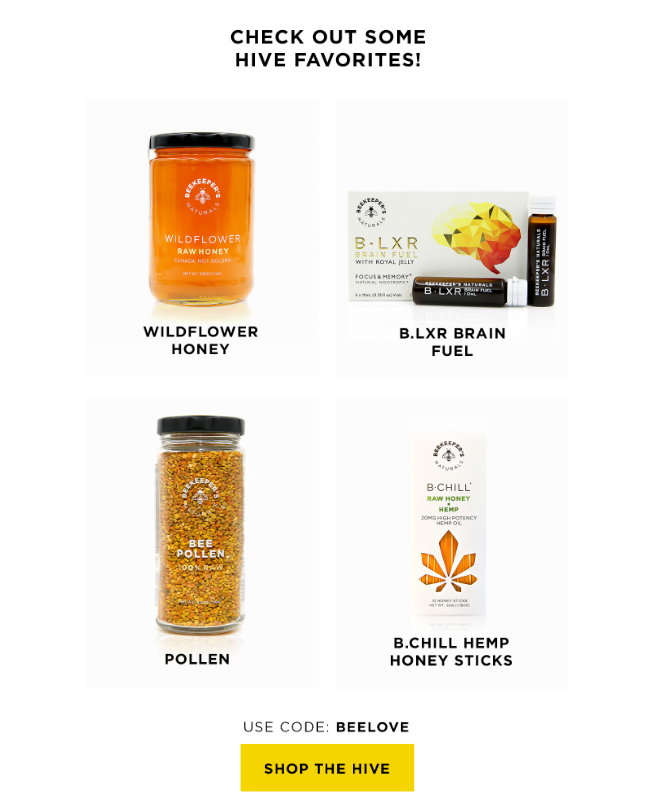
Beekeeper Naturals highlights top-sellers in their welcome sequence
4) Build authority with social proof
Your welcome sequence is the perfect chance to share just why your company is worth your customer's dollars. You can build what's called "social proof" really easily by sharing top customer reviews in your emails.
Sometimes our biggest fans give long, rambling reviews telling us allll the reasons they love us. Instead of just copy and pasting the entire review into an email, take time to excerpt one section of each review. In other words, make sure each review you share highlights one aspect of their love for your brand.
This will make them much easier to digest for your readers, and it'll make it more likely that people will actually read them instead of just skipping over the quotes.
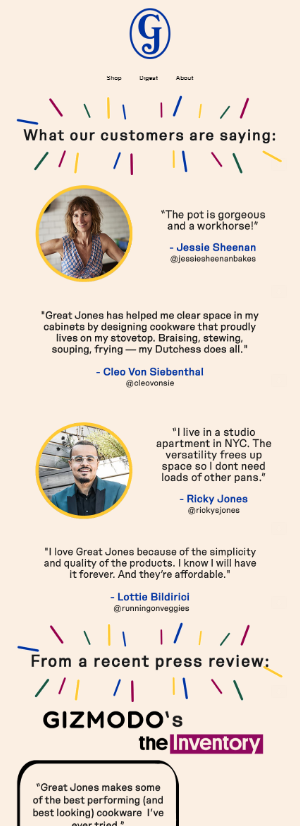
Use both customer reviews, and third-party quotes to add social proof, like Great Jones does in this email
As always, be honest in your marketing, and don't use false reviews!
5) Overcome Objections
Go ahead and answer those questions rumbling around in your audience's mind. Just because someone’s signed up for your list, doesn’t mean they’re ready to buy.
In fact, there are often barriers to overcome - especially in ecommerce where customers can’t actually smell the bouquet you're selling, or feel the cashmere sweater, or taste the chocolate.
FAQ emails are an easy way to do this. Look through your customer service tickets, online chat transcripts, or return codes to identify the topics questions and concerns that keep surfacing. Then address them head-on in your welcome sequence as one of the seven essential elements.
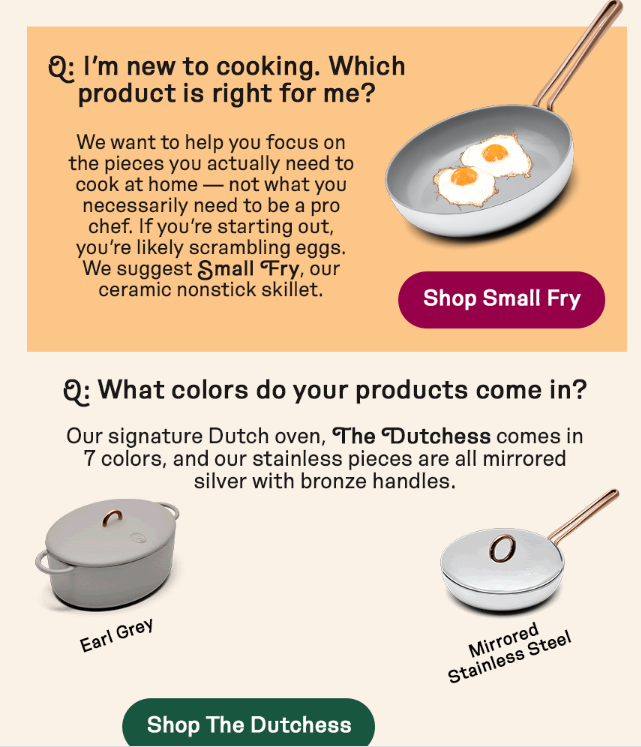
Great Jones includes an FAQ email in their welcome sequence
6) Set Expectations
Let your readers know what they can expect from you in the future - whether that's new collection previews, promo codes, or helpful content.
First, this will build excitement and anticipation around future emails.
Second, it’s a way to show integrity and trust with your readers. Mis-matched expectations often lead to disappointment, in real-life relationships, and in email marketing. Clearing up the confusion will help prevent unsubscribes.
Dudley Stephens sets an expectation for future emails right in their first welcome message
7) Provide instant value
Throughout your email relationship, you should be giving readers value. And there’s no better way to demonstrate your generosity than to start sharing value from the get-go.
There are myriad ways to do this. Here are a few ideas to get you started:
- Recipes
- Skin-care tips
- Travel tips
- Expert interviews with people in your industry or an adjacent industry (this is a great way to collaborate with like-minded brands!)
- Craft / sewing patterns
- Customer interviews (share how your products are making the lives of real people better, and how customers are making the most your products)
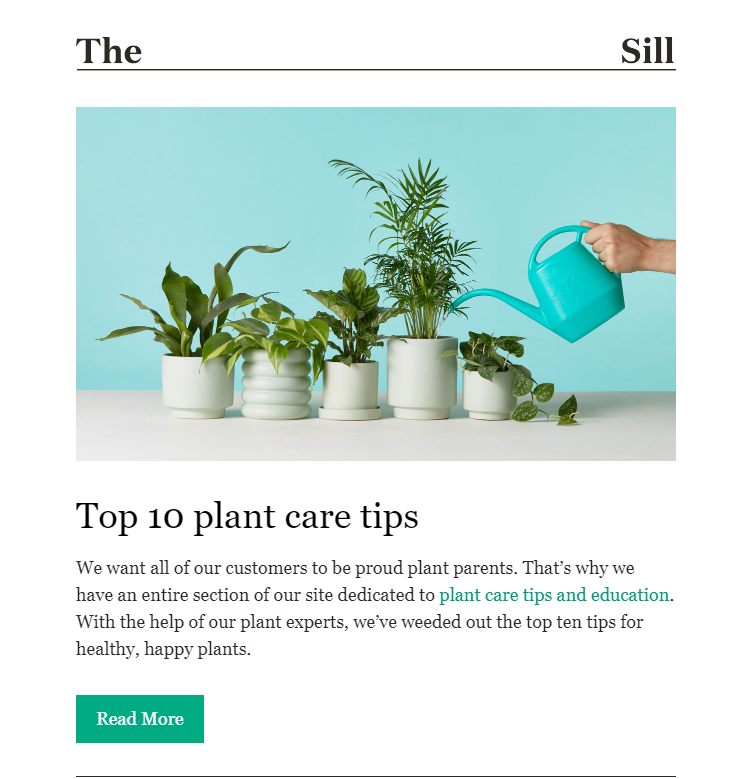
The Sill gives includes plant care education in their emails - not only is it generous, but educating your customers can increase satisfaction and decrease returns and negative reviews
Keep the momentum going
Now that you have the seven essential elements, don't stop at the end of the welcome sequence - keep the momentum going with regular emails. You should be emailing a minimum of twice a month, but more frequency is generally better. Your ultimate goal - 1 to 3 times per week.

A lot of people have a great product, but don't know how to write about it in a way customers "get."
Anna Bradshaw helps consumer brands tell their story well.
Anna uses a proven research process to write conversion copy for websites and emails - the kind of copy that gets customers clicking “buy now”.


